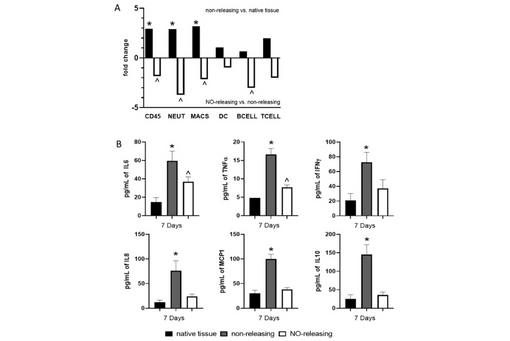Mechanisms of Foreign Body Response Mitigation by Nitric Oxide Release
Abstract
Implantable glucose biosensors provide real-time information about blood glucose fluctuations, but their utility and accuracy are time-limited due to the foreign body response (FBR) following their insertion beneath the skin. The slow release of nitric oxide (NO), a gasotransmitter with inflammation regulatory properties, from a sensor surface has been shown to dramatically improve sensors' analytical biocompatibility by reducing the overall FBR response. Indeed, work in a porcine model suggests that as long as the implants (sensors) continue to release NO, even at low levels, the inflammatory cell infiltration and resulting collagen density are lessened. While these studies strongly support the benefits of NO release in mitigating the FBR, the mechanisms through which exogenous NO acts on the surrounding tissue, especially under the condition of hyperglycemia, remain vague. Such knowledge would inform strategies to refine appropriate NO dosage and release kinetics for optimal therapeutic activity. In this study, we evaluated mediator, immune cell, and mRNA expression profiles in the local tissue microenvironment surrounding implanted sensors as a function of NO release, diabetes, and implantation duration. A custom porcine wound healing-centric multiplex gene array was developed for nanoString barcoding analysis. Tissues adjacent to sensors with sustained NO release abrogated the implant-induced acute and chronic FBR through modulation of the tissue-specific immune chemokine and cytokine microenvironment, resulting in decreased cellular recruitment, proliferation, and activation at both the acute (7-d) and chronic (14-d) phases of the FBR. Further, we found that sustained NO release abrogated the implant-induced acute and chronic foreign body response through modulation of mRNA encoding for key immunological signaling molecules and pathways, including STAT1 and multiple STAT1 targets including MAPK14, IRAK4, MMP2, and CXCL10. The condition of diabetes promoted a more robust FBR to the implants, which was also controlled by sustained NO release.
Keywords: diabetes; foreign body response; immune responses; nitric oxide; silica nanoparticles.Citation
Taylor JB, Malone-Povolny MJ, Merricks EP, Wimsey LE, Soliman D, Nichols TC, Wallet SM, Maile R, Schoenfisch MH. Mechanisms of Foreign Body Response Mitigation by Nitric Oxide Release. Int J Mol Sci. 2022 Oct 1;23(19):11635. doi: 10.3390/ijms231911635. PMID: 36232937; PMCID: PMC9569454.


